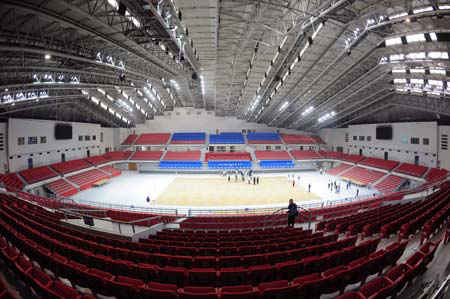
Securing The Games
- By Brent Dirks
- Aug 08, 2008
 With the eyes of the world focused on China as the 2008 Summer Olympics begin today in Beijing, numerous security companies are helping to keep fans and participants safe.
With the eyes of the world focused on China as the 2008 Summer Olympics begin today in Beijing, numerous security companies are helping to keep fans and participants safe.
Recent analysis tabbed China spending $300 million for security of Olympic venues, a figure worth $720 million of purchasing power parity.
Here’s a roundup of some of the companies providing security and safety products from all spectrums of the industry.
On the security camera side, Panasonic installed more than 2,000 surveillance cameras at the games. The company’s products, including the Super Dynamic III color PTZ cameras, will help ensure security at venues including the International Broadcasting Centre and Fencing Hall at the National Convention Center along with the Laoshan Velodrome in Beijing and Tianjin Olympic Center Stadium in Tianjin City.
 While outside the games, but no less important, Verint’s Nextiva Critical Infrastructure IP video solution is enhancing security of portions of the Beijing-Tianjin high-speed passenger rail system that is supporting passenger transit to the games. Using integrated analytics, Verint’s technology is enhancing the security of traction substation facilities located along the electrified high-speed railway. Security personnel use the integrated suite of video analytics to secure unmanned perimeters around the facilities, identify unauthorized personnel or vehicles, and proactively identify security events before they escalate.
While outside the games, but no less important, Verint’s Nextiva Critical Infrastructure IP video solution is enhancing security of portions of the Beijing-Tianjin high-speed passenger rail system that is supporting passenger transit to the games. Using integrated analytics, Verint’s technology is enhancing the security of traction substation facilities located along the electrified high-speed railway. Security personnel use the integrated suite of video analytics to secure unmanned perimeters around the facilities, identify unauthorized personnel or vehicles, and proactively identify security events before they escalate.
DDS will be providing security for more than 60 percent of the doors being protected during the games.
The company’s system will protect more than 2,000 doors across 10 main structures, including the Olympic Village, Chinese Olympic Committee Tower, Olympic Sports Center Stadium, Baseball Stadium, Bicycle Stadium, Media Center Building and Tianjin Olympic Center Stadium.
With integration into the wider security management system specially developed for the Olympics, DDS’s all-in-one card security solution also will be deployed at the Olympic Village to manage movement of thousands of athletes through more than 700 doors and 200 elevators. A single proximity badge will be used for entering the buildings, parking lots and sport facilities as well as entering points of sale spread throughout the site, simplifying access control management.
 Xtralis’ VESDA Aspirating Smoke Detection system has been deployed in a number of locations across Beijing to help protect athletic venues, mass transit systems, tourist attractions and critical infrastructure facilities
Xtralis’ VESDA Aspirating Smoke Detection system has been deployed in a number of locations across Beijing to help protect athletic venues, mass transit systems, tourist attractions and critical infrastructure facilities
The VESDA system combines advanced, proactive air sampling smoke detection technologies to effectively protect large open areas with potentially high dilution of smoke. The detectors integrate with existing fire alarm and building management systems and can be deployed across a diverse range of operating environments.
Locations protected by the system include the Beijing International Airport and the city’s mass transit system along with numerous Olympic venues and tourist attractions in the city.
To protect tickets from counterfeiting, ASK TongFang has provided contactless inlays for 12.2 million RFID tickets.
Along with anti-counterfeiting printed security features on the tickets provided by China Bank note, ASK’s partner, Tsinghua TongFang , will donate the RFID system games which includes the RFID inlays, gate readers, software and service.
Strix Systems’ Access/One Outdoor Wireless Systems (OWS) and integrated high performance Personal Mobile Command (PMC) communication systems are being deployed for emergency response vehicles and tactical mobile communications for public safety during the event.
The PMC unit is attached to public safety personnel by a small harness or belt. The unit acts as a mobile communications center with integrated wireless broadband and satellite access for live on-scene video surveillance and personal video/voice communications.
Vehicles use Strix Access/One OWS nodes providing a mix of up to six high power 802.11 a, b, g, j and 4.9 GHz (DSRC-C) radios configured for access or backhaul as needed depending on the project.
BOCOG, the Beijing Organizing Committee for the Games of the XXIX Olympiad will deploy more than 80,000 security personnel and an array of fixed and portable detection devices for these games.
This year, RAE Systems' radiation detection and wireless toxic gas monitoring equipment was permanently deployed at the Beijing Capital International Airport.
The company's devices also were used at the Barcelona (1992, summer), Salt Lake City (2002, winter), Athens (2004, summer), and Torino (2006, winter) games and the Munich World Cup (2006).
"I think it's become a very unfortunate reality that you have to do atmospheric monitoring at these events," said Bob Durstenfeld, spokesman for RAE Systems. With at least 10 heads of state and more than 100 corporate chieftains expected to attend the Beijing games, "security is paramount," he added.
Universal Detection Technology has provided radiation detection equipment for use at entrances to sports stadiums and the Olympic Village.
 American Science and Engineering Inc. is supplying its Gemini Parcel Inspection Systems to screen for explosives and contraband in parcels at key checkpoints for the games. The system has two imaging systems in one machine: dual-energy transmission for metallic detection plus proprietary Z Backscatter technology for enhanced organic detection.
American Science and Engineering Inc. is supplying its Gemini Parcel Inspection Systems to screen for explosives and contraband in parcels at key checkpoints for the games. The system has two imaging systems in one machine: dual-energy transmission for metallic detection plus proprietary Z Backscatter technology for enhanced organic detection.
Automated explosives detection systems also have been provided by L-3 Communications to the Beijing Airport. L-3's Security and Detection Systems subsidiary will supply 22 MVT-HR multi-view tomography explosives detection systems and 81 operator workstations for the hold-baggage screening system at Terminal 3, the world's largest airport terminal, which opened earlier this year.
The Occupational Health and Safety magazine team (www.ohsonline.com) -- Jerry Laws, Ronnie Rittenberry and Marc Barrera -- contributed to this report.